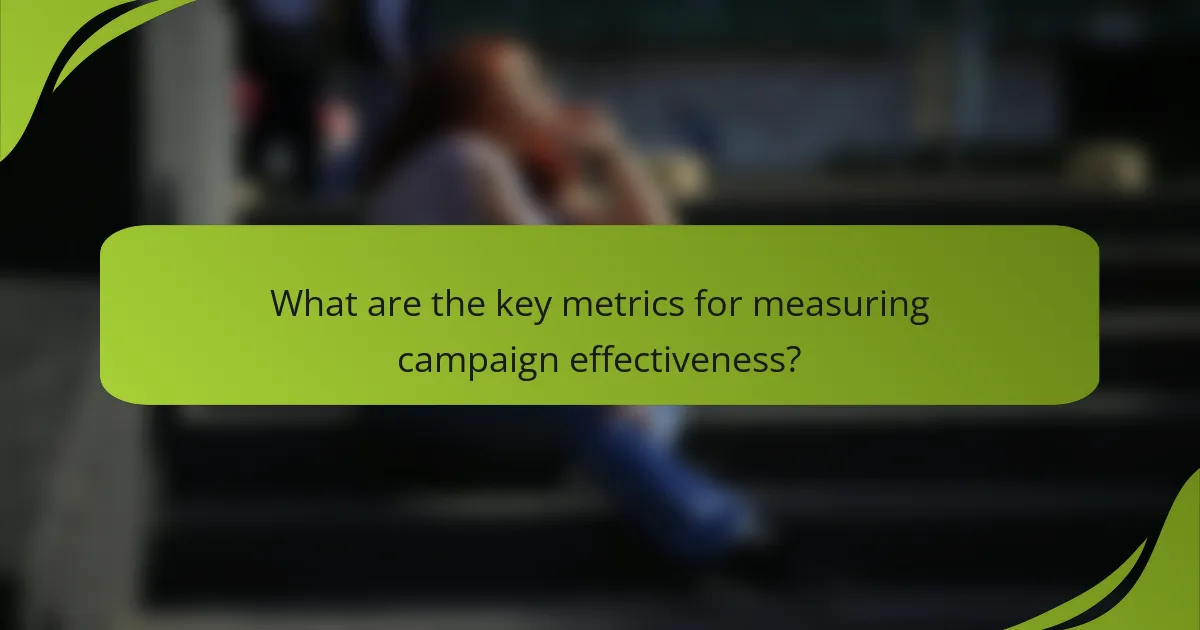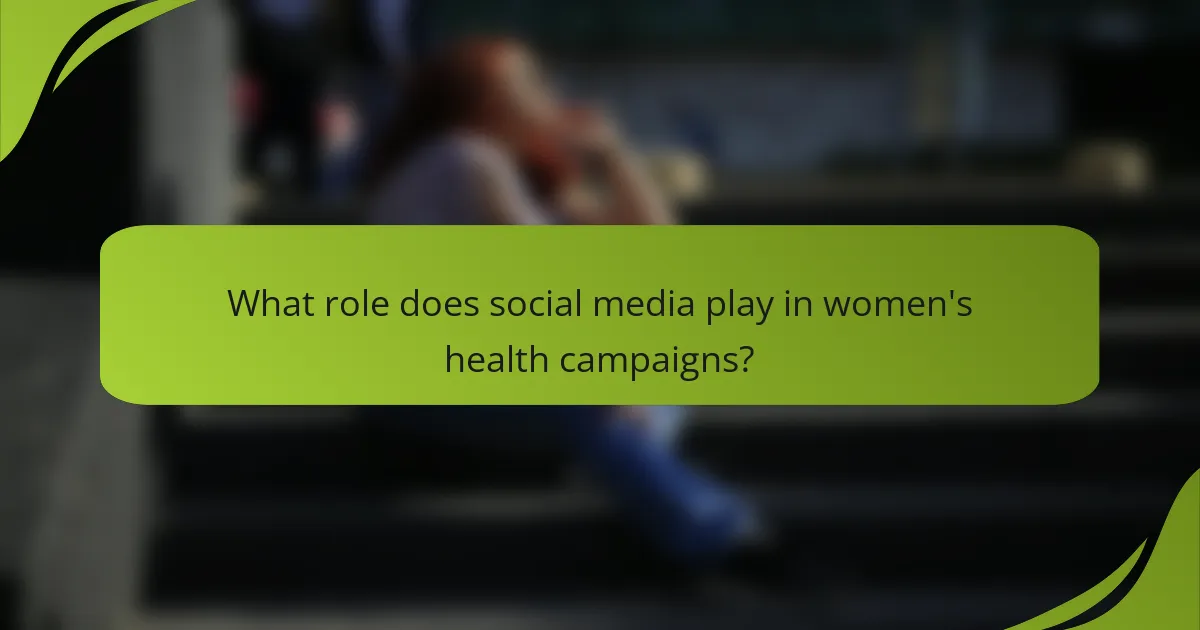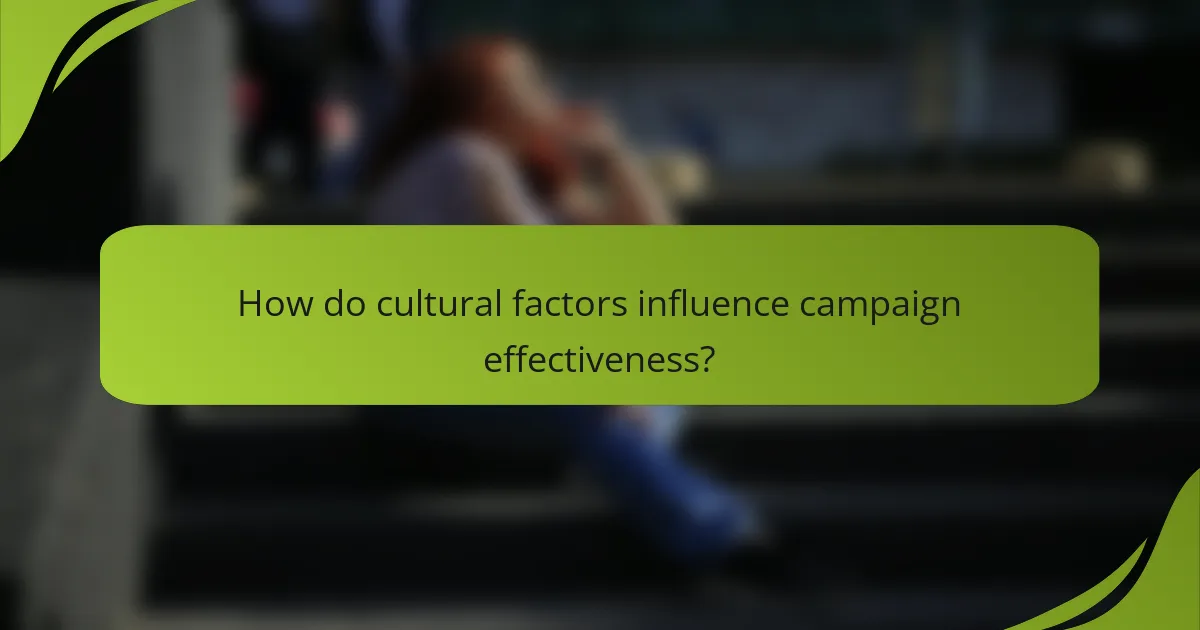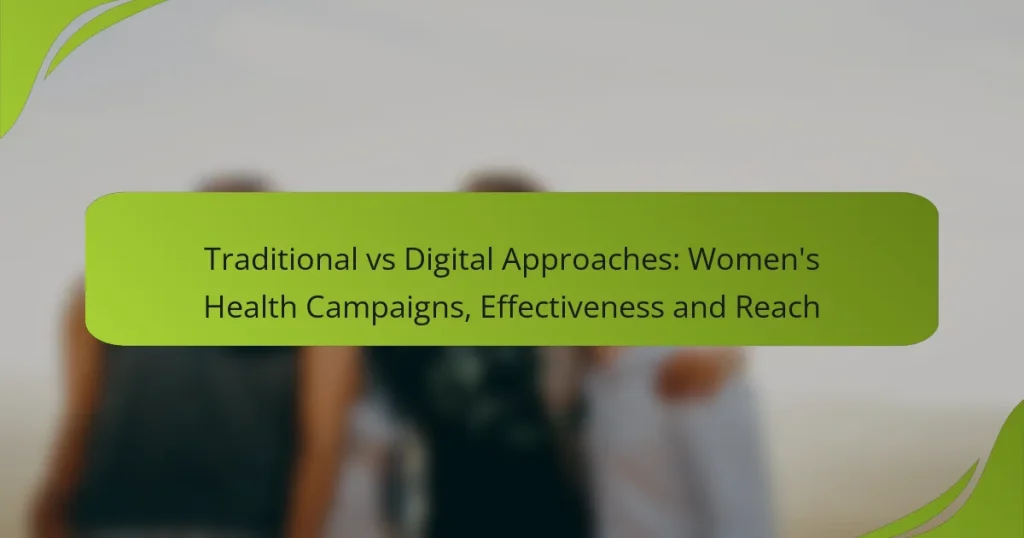In the evolving landscape of women’s health campaigns, the effectiveness and reach of traditional versus digital approaches are critical to consider. While traditional methods rely on print media and in-person events, digital strategies leverage online platforms and social media for broader outreach and targeted messaging. Understanding the strengths of each approach can enhance community engagement and improve health outcomes.

What are the most effective women’s health campaign strategies?
Effective women’s health campaign strategies combine community engagement, digital outreach, partnerships with healthcare organizations, and targeted messaging. These approaches enhance reach and impact, addressing specific health issues while fostering awareness and education.
Community engagement initiatives
Community engagement initiatives focus on involving local populations in health campaigns. This can include workshops, health fairs, and support groups that encourage participation and feedback. By fostering a sense of ownership, these initiatives can lead to higher levels of trust and effectiveness in disseminating health information.
For example, a campaign might organize a series of community meetings to discuss women’s health topics, allowing participants to share their experiences and concerns. This direct interaction can help tailor the campaign to better meet the community’s needs.
Digital outreach through social media
Digital outreach through social media platforms is crucial for reaching a broader audience quickly. Campaigns can utilize platforms like Facebook, Instagram, and Twitter to share informative content, engage users, and promote events. This method allows for real-time interaction and feedback, making it easier to adapt strategies as needed.
For instance, a campaign might create a series of short videos addressing common women’s health issues, encouraging viewers to share their stories or ask questions. This not only raises awareness but also builds a supportive online community.
Partnerships with healthcare organizations
Partnerships with healthcare organizations enhance the credibility and reach of women’s health campaigns. Collaborating with hospitals, clinics, and non-profits can provide access to resources, expertise, and networks that amplify the campaign’s message. These partnerships can also facilitate the distribution of educational materials and services.
For example, a campaign could partner with a local clinic to offer free health screenings during a community event, thus directly addressing health concerns while promoting the campaign’s goals.
Targeted messaging for specific demographics
Targeted messaging for specific demographics ensures that health campaigns resonate with diverse groups. By understanding the unique needs and preferences of different populations, campaigns can tailor their messages to be more relevant and impactful. This approach can involve adjusting language, visuals, and delivery methods based on the audience.
For instance, a campaign aimed at young women might use vibrant visuals and relatable language on social media, while a campaign for older women might focus on informative brochures distributed through healthcare providers. This strategic targeting can significantly improve engagement and effectiveness.

How do traditional women’s health campaigns compare to digital ones?
Traditional women’s health campaigns often rely on print media, events, and face-to-face interactions, while digital campaigns utilize online platforms and social media. Digital approaches generally offer broader reach and more precise targeting, making them increasingly effective in today’s health communication landscape.
Higher reach with digital campaigns
Digital campaigns can reach a vast audience quickly through social media, websites, and email marketing. For instance, platforms like Facebook and Instagram allow campaigns to target specific demographics, ensuring that messages reach women who are most likely to engage. This can result in millions of impressions within days, compared to traditional methods that may take weeks or months to achieve similar visibility.
Moreover, digital campaigns can be shared easily, amplifying their reach through user networks. This viral potential is a significant advantage over traditional media, which often has a limited distribution scope.
Cost-effectiveness of digital advertising
Digital advertising is typically more cost-effective than traditional methods such as print ads or television spots. Campaigns can be launched with budgets ranging from a few hundred to several thousand dollars, depending on the scale and targeting options. In contrast, traditional media often requires higher upfront costs for production and placement.
Additionally, digital platforms provide detailed analytics, allowing organizations to track spending and adjust strategies in real-time. This flexibility helps maximize return on investment, making it easier to allocate funds to the most effective channels.
Engagement metrics for traditional vs digital
Engagement metrics for digital campaigns often surpass those of traditional campaigns. Digital platforms allow for immediate feedback through likes, shares, comments, and click-through rates, providing insights into audience preferences and behaviors. For example, a successful digital campaign may achieve engagement rates of 5-10%, while traditional methods typically see much lower interaction levels.
In contrast, traditional campaigns may rely on indirect metrics such as surveys or sales data, which can take longer to analyze. Understanding these differences is crucial for organizations aiming to optimize their women’s health campaigns and effectively reach their target audiences.

What are the key metrics for measuring campaign effectiveness?
Key metrics for measuring campaign effectiveness include engagement rates, conversion rates, and audience reach. These metrics help determine how well a campaign resonates with its target audience and achieves its objectives.
Engagement rates
Engagement rates reflect how actively the audience interacts with campaign content. This can include likes, shares, comments, and time spent on the campaign’s digital platforms. A higher engagement rate typically indicates that the content is resonating well with the audience.
For women’s health campaigns, aim for engagement rates in the low to mid-teens percentage-wise. Strategies to boost engagement include interactive content, such as polls or quizzes, and using relatable messaging that speaks directly to women’s health issues.
Conversion rates
Conversion rates measure the percentage of users who take a desired action, such as signing up for a newsletter or making a donation. This metric is crucial for assessing the effectiveness of calls to action within the campaign. A good conversion rate for health campaigns often falls between 2-5%.
To improve conversion rates, ensure that the campaign’s messaging is clear and compelling. Use strong calls to action and consider A/B testing different approaches to see which resonates best with your audience.
Audience reach and impressions
Audience reach refers to the total number of unique individuals who see the campaign, while impressions count the total number of times the content is displayed, regardless of whether it was clicked. High reach and impressions indicate that the campaign is being widely distributed and viewed.
For effective women’s health campaigns, aim for a reach that encompasses a significant portion of the target demographic. Utilizing social media platforms and partnerships with health organizations can enhance both reach and impressions, ensuring that the campaign effectively informs and engages the intended audience.

What are the challenges faced in women’s health campaigns?
Women’s health campaigns encounter several challenges that can hinder their effectiveness and reach. These challenges include limited budgets for traditional media, difficulties in reaching underserved populations, and the need to maintain message consistency across various platforms.
Limited budget for traditional media
Many women’s health campaigns operate with constrained budgets, which significantly limits their ability to utilize traditional media channels like television, radio, and print. These channels often require substantial investment, making it difficult for organizations to achieve widespread visibility.
To maximize impact within a limited budget, campaigns can prioritize cost-effective strategies such as community partnerships and local events. Utilizing social media and digital platforms can also provide a more affordable alternative to traditional media, allowing for targeted outreach.
Reaching underserved populations
Underserved populations often face barriers such as language, cultural differences, and lack of access to healthcare information. These factors can make it challenging for women’s health campaigns to effectively engage these groups and ensure they receive critical health information.
To address these challenges, campaigns should consider tailoring their messages to resonate with specific communities. Collaborating with local organizations and utilizing culturally relevant materials can enhance outreach efforts and improve engagement with underserved populations.
Maintaining message consistency across platforms
Consistency in messaging is crucial for the success of women’s health campaigns, yet it can be difficult to achieve across various platforms. Different media may require adjustments in tone and style, which can lead to mixed messages if not carefully managed.
To maintain message consistency, campaigns should develop a clear communication strategy that outlines key messages and branding guidelines. Regular training for team members and consistent monitoring of all platforms can help ensure that the campaign’s core message remains unified and recognizable.

What role does social media play in women’s health campaigns?
Social media serves as a powerful tool in women’s health campaigns by enhancing outreach and engagement. It allows organizations to connect directly with audiences, share vital information, and foster community involvement.
Building community support
Social media platforms enable the formation of supportive communities around women’s health issues. These online spaces allow individuals to share personal experiences, seek advice, and provide encouragement to one another. Campaigns that actively engage users can cultivate a sense of belonging and solidarity, which is crucial for promoting health awareness.
For instance, a campaign focused on breast cancer awareness can create dedicated groups where survivors and supporters share stories and resources. This peer support can significantly increase participation and advocacy for health initiatives.
Real-time feedback and engagement
Social media facilitates immediate feedback from the audience, allowing campaigns to adjust their strategies quickly. Organizations can monitor comments, shares, and reactions to gauge the effectiveness of their messaging and make necessary changes in real time. This responsiveness can enhance the relevance of the campaign and improve its impact.
For example, if a campaign on reproductive health notices a surge in questions about a specific topic, they can address this in follow-up posts or live Q&A sessions, ensuring that the information shared meets the audience’s needs.
Influencer partnerships
Collaborating with influencers can amplify the reach of women’s health campaigns significantly. Influencers often have established trust with their followers, making their endorsements more impactful. By partnering with health advocates or public figures, campaigns can tap into new audiences and enhance credibility.
For instance, a campaign promoting mental health awareness might engage a well-known mental health advocate to share personal stories and resources. This can lead to increased visibility and engagement, driving more individuals to seek help or participate in health initiatives.

How do cultural factors influence campaign effectiveness?
Cultural factors significantly impact the effectiveness of women’s health campaigns by shaping how messages are received and understood. Campaigns that align with cultural values and norms tend to resonate better with the target audience, leading to increased engagement and positive health outcomes.
Tailoring messages to cultural norms
To enhance campaign effectiveness, messages should be tailored to reflect the cultural norms of the target audience. This involves using language, imagery, and themes that are familiar and relatable to the community. For instance, a campaign promoting reproductive health in a conservative society might focus on family values and maternal health rather than individual autonomy.
Additionally, utilizing local dialects or culturally relevant symbols can strengthen the connection with the audience. Campaigns that respect and incorporate cultural practices are more likely to be accepted and acted upon, as they demonstrate an understanding of the community’s identity.
Understanding local health beliefs
Local health beliefs play a crucial role in shaping how women perceive health issues and interventions. Campaigns must consider prevalent beliefs about health, illness, and medical practices within the community. For example, in some cultures, traditional medicine may be preferred over modern healthcare solutions, necessitating a blended approach in messaging.
Engaging with local health practitioners and community leaders can provide valuable insights into these beliefs. This collaboration can help in designing campaigns that not only inform but also respect and integrate local practices, thus increasing the likelihood of acceptance and participation in health initiatives.


